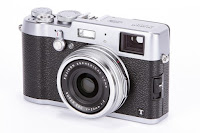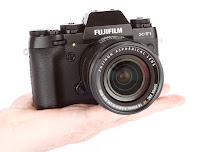What is camera?
A camera is an optical instrument for recording or capturing images, which may be stored locally, transmitted to another location, or both. The images may be individual still photographs or sequencesof images constituting videos or movies.The camera is a remote sensing device as it senses subjects without physical contact. The word camera comes from camera obscura, which means "dark chamber" and is the Latin name of the original device for projecting an image of external reality onto a flat surface. The modern photographic camera evolved from the camera obscura. The functioning of the camera is very similar to the functioning of the human eye.
Kinds of cameras nowadays
Digital compact cameras
This includes following types:
-Simple point and shoot
 |
Not so great for: anyone wanting to take control over camera functionality
|
-Standard compact cameras
 |
Great for: Slipping in a bag/purse, style-conscious users
Not so great for: Larger-handed users |
-Enthusiast compact cameras
 |
Great for: Creative photography on the fly, low-light situations
Not so great for: Those on a budget, ‘point-and-shoot’ |
Superzoom bridge cameras
This includes following types:
-Superzoom cameras (also called Bridge cameras)
 |
Great for: Outdoor activities, travel
Not so great for: Slipping in your pocket |
Interchangeable lens cameras
This includes following types:
-Compact System (Hybrid/mirrorless) camera models
 |
Great for: Alternative to enthusiast compacts, street and travel photography
Not so great for: Any subject requiring the faster focusing a DSLR provides, viewfinder fans |
-DSLR(Digital Single Lens Reflex cameras) cameras
 |
Great for: Image requiring the best quality, action photography, those looking to experiment with video recording
Not so great for: Portability, those on a budget |
Camera accessories
Accessories for cameras are mainly for care, protection, special effects and functions.
-Lens hood: used on the end of a lens to block the sun or other light source to prevent glare and lens flare (see also [[matte box]]).
-Lens cap: covers and protects the lens during storage.
-Lens adapter: sometimes called a step-ring, adapts the lens to other size filters.
-Photographic filter/Lens filters: allow artificial colors or change light density.
-Extension tube/Lens extension tubes: allow close focus in (macro photography).
-Flash (photography)|Flash equipment: including [Diffuser (optics)|light diffuser], mount and stand, reflector, (soft box), trigger and cord.
-Care and protection: including camera case and cover, maintenance tools, and screen protector.-magnifier loupe, view finder, angle finder, focusing rail /truck:Large format (photography)|Large format cameras use these special equipment.
-Battery and charger
-Tripod stand, microscope adapter, Bulb (photography)|cable release, electric wire release etc.
History of camera
The Ancient Greeks and Chinese used an optical device called the ‘camera obscura’ to project an image of the surroundings on to a screen. This invention played an important role in the development of cameras and photography.
-Although designs existed earlier, it wasn't until the 1800s that practical cameras were developed.
-The ‘Kodak’ camera was developed by George Eastman and went on sale in 1888, pioneering the use of photographic film. It was simple box camera with a single shutter speed and fixed focus lens.
-Around the year 1913, a German optical engineer named Oskar Barnack made a prototype compact camera that used 35 mm film. Named ‘Lecia’, it was put into production in 1925 after further developments.
-Reflex cameras became popular in the 1920s and 1930s.
-Single lens reflex cameras (SLR) use a mirror and prism system to allow photographers to accurately see the image that will be captured. This system uses one optical light path whereas previous cameras had two, one through the lens to the film and the other to the viewfinder.
-Polaroid cameras hit the market in 1948, allowing photographers to produce images instantly. A special chemical process was used to used to produce prints from the negatives in under a minute.
-The popularity of instant cameras took off in 1965 with the introduction of the Polaroid Model 20 Swinger, one of the top selling cameras of all time.
-Despite the technology being around in 1949, disposable cameras didn't really catch on until the 1990s when Kodak models became popular. They are cheap alternatives designed to be used once, perfect for one off events such as birthdays and vacations.
-The first successful imaging technology using a digital sensor was made in 1969 by Willard S. Boyle and George E. Smith. In 2009, they were awarded the Nobel Prize in Physics for their contributions which paved the way for digital photography.
-The first commercial DSLR (digital single lens reflex) was launched by Kodak in 1991.
-Photos on digital cameras are typically compressed using the JPEG standard and stored on memory cards.
-The popularity of digital cameras exploded in the 2000s as technology improved and the costs of production decreased.
-Modern digital cameras produce detailed photos made up of a huge number of pixels.
-The technology behind cameras is improving all the time with additions such as touch screens and electronic viewfinders.
No comments:
Post a Comment